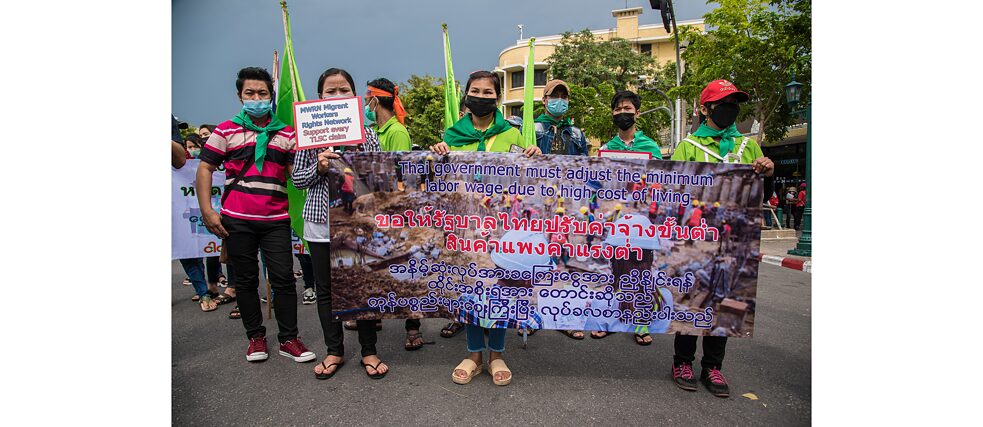Labour Market Revolution Opportunities and Risks of a Global Minimum Wage

Rally for minimum wage increase. Kim Dong-myung (L), leader of the Federation of Korean Trade Unions and Yang Kyung-soo, chief of the Korean Confederation of Trade Unions, take part in a rally in front of the government complex in Sejong, central South Korea, on 28th June 2022, to declare their campaign to seek an increase in the minimum wage. Representatives of employers, workers and the government are set to hold a plenary session of the minimum wage committee the same day to set next year's minimum hourly wage.
| Photo (detail): Yonhap © picture alliance / YONHAPNEWS AGENCY
Is a global minimum wage feasible? Labour market researcher Ralf Himmelreicher says yes, but the hurdles are high and it would not only have advantages.
According to the International Labour Office (ILO), over a hundred and therefore more than half of all countries in the world had national minimum wage regulations in 2020. In other words, each of these independent countries has a statutory minimum wage, which, however, varies widely in amount and level from one country to another. The countries without a minimum wage are mostly in the Global South, but they also include a few Scandinavian countries and Austria. In Austria, wages in the lower wage groups are by large negotiated through collective agreements, so there is no need for a state-imposed minimum wage. Ideally, the chance of a global minimum wage would lie in the fact that after its introduction there should not be a single employee worldwide who would be paid below this defined wage threshold.Advantages and disadvantages
A global minimum wage offers the chance to put an end to unconscionably low wages with a “race to the bottom” and, as a result, to the existence and emergence of “low-wage countries” with below-average labour costs and rampant exploitation. It would level the playing field by preventing producers from offering products that benefit from competitive advantages due to very low labour costs. Furthermore, a global minimum wage would reduce poverty risks and improve the living and working conditions of employees in this wage segment and their families. Wages and state transfer payments are largely interdependent especially in countries with well-developed social security systems, so a minimum wage could reduce the amount of such transfers.The principal risk of introducing a global minimum wage, on the other hand, is that rising labour costs would make it unprofitable to produce certain goods and services, and reduce the number of available jobs as a result. Prices and labour intensity might be increased, and working hours shortened, to offset the higher labour costs. Also the production might be shifted to more capital-intensive methods that require less labour force.
It’s clear from these few pros and cons alone that introducing a global minimum wage is complicated, to say the least. Predicting the consequences is a complex matter and it requires a valid pool of data, which is often unavailable or not forthcoming for research purposes, especially in countries outside the Organisation for Economic Co-operation and Development (OECD).
Who would benefit from a global minimum wage?
Gainfully employed workers in most countries are entitled to a minimum wage from the age of 18. On the other hand, self-employed workers and contractors as well as “click workers” and “crowdworkers” are not entitled to a minimum wage. Nor are trainees and interns whose training is more about gaining skills than doing productive work. The employment of day labourers and “family workers” constitutes a grey zone because they have so little power in the labour market that it is often all but impossible for them to assert their rights. Some countries have lower minimum wages for workers under 21 years of age or minimum wage levels that are graduated according to age groups. Workers in state-subsidised sectors of the labour market, such as workshops for the mentally and physically impaired, are not entitled to a statutory minimum wage either. Existing minimum wages usually don’t apply to gainfully employed convicts either.How high should a global minimum wage be?
The European minimum wage initiative proposes the so-called Kaitz Index as a benchmark for a relative minimum wage. This index is based on the national average income (median wage) of full-time employees in the country concerned. The target minimum wage in the EU is 60 per cent of the median wage, meaning that if the median national gross hourly wage in a given country is 15 euros, for example, the minimum wage would have to be nine euros. The example refers to gross hourly wages. But determining hourly wages requires a differentiated calculation of working hours to allow for breaks and overtime, which is often impossible. So some countries, such as Malta, have daily, weekly or monthly minimum wages. The monthly minimum wage may be based on the “at-risk-of-poverty threshold” or the threshold to ward off old-age poverty.In addition to relative minimum wages, global minimum wages could also be set in absolute terms or in terms of the prices of essential consumer goods. This would mean paying every gainfully employed person at least, say, one dollar per hour or setting monthly income at a level high enough to cover minimum household needs based on national minimum wage guidelines and the current cost of living. The problem with absolute minimum wage concepts of this kind is that unless wage increases or inflation are automatically indexed, they usually can’t be taken into account until after a certain time lag. Purchasing power may also need to be factored into comparisons of national minimum wages. The current increase in prices for food, housing and energy, and the decrease of prices for means of communication, illustrate the complexity of an appropriate consideration of the price development for households with employees from lower wage groups.
“An important step in the right direction”
To sum up, the outsourcing of production to so-called “low-wage countries” could be curbed by introducing a global minimum wage, with positive effects in terms of sustainability, but potentially adverse effects on employees in the global South as well as probable price increases. If the International Labour Office (ILO) or the United Nations (UN) seek to introduce a global minimum wage, it would be important for national minimum wages to be introduced and firmly established first in the nations of the global South, along with institutions to monitor compliance with workers’ rights. Once this foundation is in place, the next step could be the negotiation of global minimum wages, which should be based on the Kaitz Index.The Kaitz Index should not be set too high at first so that a global minimum wage can prove itself economically viable and, along with working conditions, amenable to effective monitoring. The convergence of global minimum wages could be successively achieved through benchmarking by the ILO or UN. Less democratically governed countries with no separation of powers and scant protection for workers’ rights are likely to put up heavy resistance to a global minimum wage. But trade agreements could be used to enforce compliance with a global minimum wage as a prerequisite for continued trading. In this respect, a global minimum wage would be an important step in the right direction. And if it were reinforced by easily accessible local or sector-specific efforts to help workers help themselves, “starvation wages” could be abolished even in low-wage countries.




0 0 Comments